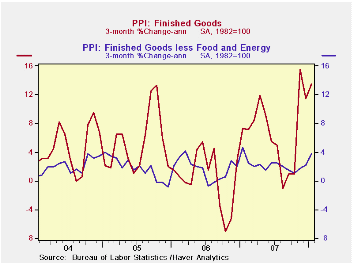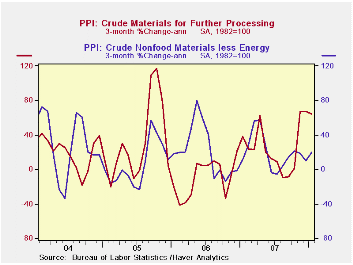 Global| Feb 26 2008
Global| Feb 26 2008U.S. PPI Total & Core Strong
by:Tom Moeller
|in:Economy in Brief
Summary
Finished producer prices surged 1.0% during January following a 0.3% dip in December. The latest increase was triple Consensus expectations for a 0.3% rise. At an annual rate the PPI is up 13.5% during the last three months. Less food [...]

Finished producer prices surged 1.0% during January following a 0.3% dip in December. The latest increase was triple Consensus expectations for a 0.3% rise. At an annual rate the PPI is up 13.5% during the last three months.
Less food and energy this measure of core prices rose 0.4% and it was double expectations. At an annual rate core producer prices have risen 3.7% during the last three months.
Energy prices made up half of December's decline with a 1.5% rise (+23.7% y/y). Gasoline prices rose 2.9% (48.1% y/y) after a 7.6% December drop. Home heating oil prices surged 8.5% (48.% y/y) and natural gas prices rose 0.7% (0.6% y/y) after five consecutive months of decline.
Why Do Gasoline Prices React to Things That Have Not Happened? from the Federal Reserve Bank of St. Louis is available here.
Finished consumer food prices jumped 1.7% (8.2% y/y) after an upwardly revised 1.4% December surge. During the past three months food prices have risen at a 12.0% annual rate.
Prices of core finished consumer goods rose 0.4% (2.7% y/y) lifted by a 0.8% rise (-0.5% y/y) in passenger car prices and a 0.4% (1.6%) gain in prices of household appliances. Core consumer nondurables prices were strong again and rose 0.4% (3.9% y/y). The three month gain in these prices is 3.9%. Pharmaceutical prices have been quite strong but apparel prices have been flat. 
Capital equipment prices also rose 0.4% (1.6% y/y) after a 0.1% December uptick. Heavy truck prices rose 0.4% (3.3% Y/Y) but prices for light trucks fell 0.2% (+0.2% y/y), down for the second consecutive month.
Intermediate goods prices surged 1.4% after a modest 0.2% December decline. Excluding food & energy prices also were strong. They posted a 0.8% increase led by strength in industrial chemical prices which have risen 40.7% (AR) over the last three months. Steel mill prices also have been strong but copper prices have been down.
The crude materials PPI surged 2.5%, more than double the strong December rise. Crude energy materials prices jumped 1.8% (40.9% y/y). The core crude materials PPI surged 4.0% (21.0% y/y) as prices for iron & steel scrap as well as prices for aluminum scrap have been quite strong.
| Producer Price Index | January | December | Y/Y | 2007 | 2006 | 2005 |
|---|---|---|---|---|---|---|
| Finished Goods | 1.0% | -0.3% | 7.7% | 3.9% | 3.0% | 4.9% |
| Core | 0.4% | 0.2% | 2.4% | 1.9% | 1.5% | 2.4% |
| Intermediate Goods | 1.4% | -0.2% | 9.1% | 4.1% | 6.4% | 8.0% |
| Core | 0.8% | 0.0% | 4.1% | 2.8% | 6.0% | 5.5% |
| Crude Goods | 2.5% | 1.1% | 31.0% | 12.2% | 1.4% | 14.6% |
| Core | 4.0% | 0.2% | 21.0% | 15.9% | 20.8% | 4.9% |
Tom Moeller
AuthorMore in Author Profile »Prior to joining Haver Analytics in 2000, Mr. Moeller worked as the Economist at Chancellor Capital Management from 1985 to 1999. There, he developed comprehensive economic forecasts and interpreted economic data for equity and fixed income portfolio managers. Also at Chancellor, Mr. Moeller worked as an equity analyst and was responsible for researching and rating companies in the economically sensitive automobile and housing industries for investment in Chancellor’s equity portfolio. Prior to joining Chancellor, Mr. Moeller was an Economist at Citibank from 1979 to 1984. He also analyzed pricing behavior in the metals industry for the Council on Wage and Price Stability in Washington, D.C. In 1999, Mr. Moeller received the award for most accurate forecast from the Forecasters' Club of New York. From 1990 to 1992 he was President of the New York Association for Business Economists. Mr. Moeller earned an M.B.A. in Finance from Fordham University, where he graduated in 1987. He holds a Bachelor of Arts in Economics from George Washington University.






